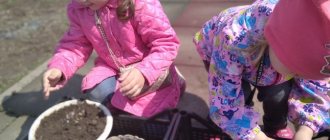Card index of didactic games on gender education of children in the middle group
Municipal budgetary preschool educational institution kindergarten No. 10 “Solnyshko”
Play as a means of educating preschoolers
Play, according to teachers, is the best method of learning anything. While playing, the child does not think about the fact that this is study and they want something from him. He simply performs actions that interest him and easily, naturally remembers a lot of necessary information.
Gender games for preschoolers are one of the ways to explain how girls and boys should behave, what rules their behavior in society is subject to. The outdated stereotype “cars for boys, dolls for girls” has long since become obsolete; modern early development methods tell a completely different story. In addition, the lines between male and female professions are gradually blurring; many women are passionate about the ideas of feminism. Because of this, it becomes more difficult for the younger generation to adapt to their role, and many parents and especially grandmothers are opposed to new practices, when boys playing with dolls and “mother-daughter” are not only allowed, but also encouraged, and girls dream of becoming not a housewife, but, say, a prime minister.
Project objectives:
Didactic game
"Ears on top of the head."
Goals:
- Development of auditory attention.
- Teach children to identify themselves and the people around them by gender role.
Progress of the game:
The adult calls several names. Children need to listen carefully and say the extra name. Explain why they consider this or that name “superfluous.”
For example, Seryozha, Misha, Lena; Natasha, Dasha, Dima.
Didactic game
"Gifts for Sasha and Masha."
Target:
- formation of gender ideas in children.
Tasks:
consolidate the ability to recognize oneself and other children as representatives of a certain gender; continue to develop an interest in the life and activities of other representatives of the same and opposite sex;
develop thinking and imagination;
foster friendly relationships between children.
Material:
two dolls - a girl Dasha and a boy Sasha, two boxes (red, for Masha, and the other blue, for Sasha) containing “Gifts” (pictures depicting various objects - toys, clothes for girls and boys, as well as objects, not having a specific gender).
Progress of the game:
During the game, children need to correctly determine who the gift is intended for.
Didactic game
“How are our mothers similar?”
“How are our dads similar?”
Goals:
- To develop the ability to identify significant similarities and differences between representatives of different sexes.
- Cultivate love for loved ones and respect for their work.
- Help your child express his feelings to people close to him.
Material:
family album photographs of each child.
Progress of the game:
Children and an adult are sitting on the carpet. The teacher tells the children that each of them has a family, there are mothers, fathers, grandparents, brothers and sisters. Children are asked, looking at a photo of their mother (their father), to tell what kind of mother (father) they have? What does she do? For example, my mother is kind, affectionate, sometimes angry, thin, caring, beautiful. She cooks food, washes clothes, etc.
After all the children answer, the teacher asks them a question:
-How are our mothers (fathers) similar?
-What housework duties do all mothers (fathers) perform?
-What external signs unite them?
-What qualities are inherent in all mothers (fathers)?
-Who will you be when you grow up?
After listening to the children's answers, the teacher sums up that all mothers and fathers do housework, raise children, and go to work. All mothers and fathers love their children and take care of them
Didactic game
"Noble Deeds"
Target
:
- To instill in children the desire to do things for the sake of other people.
- To form an understanding that we call an action not only heroism, but also any good deed for the sake of another person.
Material:
ball
Progress of the game
:
Children are asked to list noble deeds towards girls (women) and boys (men). The teacher throws the ball into the hands of one of the players, he names a noble deed and throws the ball to the next player at his request.
For example, noble deeds for boys:
call the girl by name only; when meeting a girl, say hello first; give up your seat in transport; never offend a girl; protect the girl; help the girl carry heavy things; when a girl gets out of the transport, you need to get out first and give her your hand; the boy must help the girl get dressed, give her a coat, etc.
Noble deeds for girls: call a boy by name only; when meeting a boy, say hello; praise the boy for showing attention; do not offend or call the boy names, especially in the presence of other children; thank the boy for his good deeds and deeds; etc.
Progress of the game:
1. Girls and boys sit opposite each other. 2. The boys start the game. They take turns calling any girls' names. 3. If there is a girl whose name was spoken, she stands up and says her name again and talks a little about herself. 4. After this, it’s the girls’ turn and they start calling out the boys’ names.
Note.
Children's stories should not be very long or very short. To make a small self-portrait, the presenter must help the children.
Didactic game
"The Absent-Minded Artist"
Target:
- consolidate knowledge about adult professions and tools.
Material:
set of pictures.
Progress of the game:
The cards depict people of different professions, holding tools in their hands. It is necessary to correct the artist's mistakes. Description of the cards: the doctor has a hammer, the carpenter has a thermometer.
MAGAZINE Preschooler.RF
Didactic games with children on gender educationHow we raise our children, what personal qualities we can develop in them, taking into account their individual and gender characteristics, directly determines what kind of women and men they will become in the future, what kind of parents they will be for their children. Observing modern children, it can be noted that girls become aggressive and rude, and boys adopt a feminine type of behavior. Many girls lack modesty, tenderness, patience, and do not know how to peacefully resolve conflict situations. Boys, on the contrary, do not know how to stand up for themselves, are physically weak, lack stamina, and they lack a culture of behavior towards girls. The content of children’s games is also alarming: children demonstrate patterns of behavior that do not correspond to the child’s gender, do not know how to negotiate in the game, or assign roles. In addition, in the process of working, children find it difficult to independently distribute responsibilities taking into account the gender of their partner. Boys do not show a desire to come to the aid of girls when physical strength is needed, and girls are in no hurry to help boys where thoroughness and accuracy are needed.
We offer gender education games that will teach children to be attentive to each other and to be able to show sympathy for children of the same and opposite sex.
"Noble deeds"
Children are asked to list noble deeds towards girls (women) and boys (men). The teacher throws the ball into the hands of one of the players, he names a noble deed and throws the ball to the next player at his request. Call the girl/boy by name only; When meeting someone, say hello first.
"Correct the mistake"
To develop knowledge about the rules of etiquette behavior for boys and girls, children are asked to find the “correct” picture and explain their choice. The boy is sitting on the bus, the girl is standing. The girl is sitting on the bus, the boy is standing. A boy smells flowers, a girl carries a bucket of water for irrigation. A girl smells flowers, a boy carries a bucket of water for irrigation.
"Find it right"
To form children's ideas about gender-role stereotypical types of human activity, children are asked to select objects of labor for a boy and for a girl.
“Who wears what?”
To develop the ability to find characteristic differences in the appearance of a boy and a girl, children are invited to choose clothes and accessories for the boy and girl.
“Who works for whom?”
To develop knowledge about the gender component of the profession, children are asked to lay out large cards according to the principle: male/female professions, neutral professions; choose professional tools. The game is accompanied by comments from the children.
"Names"
The teacher places paper cut-out figures of a boy and a girl in front of the child and offers a game: he will name the names, and the child will decide which name is suitable for whom. The teacher monitors the child’s choice, and in ambiguous cases, in a conversation with the child, finds out who (a boy or a girl) the name suits more; would he like to have such a “double” name, etc.
"Ears on top of your head"
The adult calls several names. Children need to listen carefully and say the extra name. Explain why they consider this or that name “superfluous” .
"We're going to visit"
The teacher invites the children to compete to see who can get ready to visit faster. Two (three) children play. They approach the tables and begin to gather for a visit. The adult reminds the children that in order to go on a visit, they need to get themselves in order: dress nicely, comb their hair, etc. The rest of the children are watching their friends. Can they go there right now? Which of the girls will agree to help them?
| Next > |
System of work on the use of didactic games
in gender education of preschool children
The problem of sex education for the younger generation, which allows us to see differently the specifics of pedagogical work with preschool children, is one of the most complex and controversial; the psychological, social and spiritual health of society largely depends on its solution. Today, the problem of raising a child, taking into account gender differences in significance and relevance, has no analogues; it is closely related to the humanization of the pedagogical process, because sets prospects for a person’s further participation in public life, prepares him to fulfill social roles in society and family.
Therefore, it is important to support and develop girls’ softness, responsiveness, tenderness, accuracy, and desire for beauty. And boys have courage, firmness, determination, a chivalrous attitude towards representatives of the opposite sex, i.e. prerequisites for future femininity or masculinity. If the foundations of these qualities are not laid in the preschool years, and it is precisely this age that many researchers define as the initial stage of sexual socialization, then, upon becoming an adult, a person copes poorly with his social roles, the process of assimilating cultural norms, values, and stereotypes of gender-role behavior accepted in a particular society.
Gender-role education involves purposeful pedagogical activity during the life of a child, his general development, nurturing relationships with adults and children, both of the same sex and the opposite. Practical workers and teachers do not always seriously think about how to build relationships between boys and girls in a group; they do not sufficiently take into account their physical capabilities, their interests and needs, and experience difficulties in implementing differentiated education taking into account gender. We can say that the processes of sexual differentiation and identification of preschool children occur spontaneously. Therefore, we have developed a system of didactic games aimed at positive gender role socialization of preschool children.
Junior group
1. D/i “Toys for boys and girls”
Goal: to consolidate children’s knowledge about the range of interests and various types of activities of children depending on gender.
Material: cards with images of girls and boys, cards with images of various toys.
Progress of the game: the teacher distributes large cards to the children; cards with pictures of toys lie in the middle of the table. Children take turns choosing a card with a toy and putting it in their card. After filling out the entire card, they explain their choice.
2. D/i “Fold the picture”
Goal: to consolidate ideas about the differences between boys and girls, to develop attention.
Material: pyramid consisting of parts.
Progress of the game: in front of the child lies a disassembled pyramid. Children are asked to assemble a pyramid to create an image of a boy or girl on all sides.
3. D/i “Who wears what”
Goal: to develop the ability to find differences in the appearance of boys and girls.
Material: cards with images of boys and girls who do not have enough items of clothing, pictures with images of clothes.
Progress of the game: the teacher distributes cards, chooses the leader who has the clothes. The presenter takes turns showing items of clothing, the children choose whether it suits their picture or not. The winner is rewarded with applause.
Middle group
1. D/i “Magic Flower”
Goal: to form an idea of the household responsibilities of women and men, girls and boys. Cultivate a desire to help people.
Material: flower made of multi-colored cardboard, petals are removable, inserted into the middle
Progress of the game: children take turns tearing petals from a flower, naming the duties they perform in the family (watering flowers, sweeping the floor, caring for animals, “raising” younger sisters and brothers, repairing toys, etc.). You can diversify the game. Let the children list the responsibilities that their mothers and then their fathers perform in the family.
2. D/i “I know five names”
Goal: to develop the ability to name the names of girls and boys based on the proposed pictures. Match the name to the gender of the child. Develop attention and observation.
Material: pictures depicting silhouettes of boys and girls, 5 pieces each, chips.
Progress of the game: the teacher distributes silhouettes depicting boys and girls. You can distribute pictures with boys to boys, with girls to girls and vice versa. Or maybe at random. Children call names. For each correctly named name, one chip is given. Whoever gets five chips first wins.
3. D/i “Our hairstyles”
Goal: To form children’s ideas about the hairstyles of boys and girls.
Material: images of a person's face, samples of hairstyles for boys and girls.
How to play: You can play individually with a child, or you can play with a group of children. Children are given pictures of a person's face. The teacher asks you to choose a hairstyle for a boy or a girl.
Senior group
1. D/i “What first, what then”
Goal: to consolidate children’s knowledge about age-related changes in people of different sexes, to educate gender identity.
Material: a set of pictures depicting age-related changes in people of different sexes, pockets.
Progress of the game: the teacher lays out the cards on the table. He first invites the girls to the table and invites them to select and arrange in the correct sequence cards with images of girls that change with age. After completing the task, the teacher invites the boys to the table to check the correctness of the task. Then the boys perform the same task, and the girls control the correct execution.
2. D/i “Girls and Boys”
Goal: to develop the ability to name qualities characteristic of girls and boys. Develop coherent speech.
Material: pictures of boys and girls, chips.
Progress of the game: the teacher hands out pictures to the children and asks them to name the good qualities that girls and boys have. The child names the qualities of the one depicted in his picture. A chip is given for the correct answer. Whoever has the most chips wins.
Preparatory group
1. D/i “Packing your suitcase”
Goal: to consolidate the gender role behavior of boys and girls.
Material: charts of male and female behavior.
Progress of the game: children are asked to choose those character traits that help a man and a woman in life, contribute to the ability to see and understand another. Explain what this diagram means.
2. D/i “Guess the profession”
Goal: to consolidate children’s knowledge about male and female professions. Develop the ability to solve riddles.
Material: cards with images of people of different professions, cards with riddles.
Progress of the game: the teacher reads the riddle, and the children guess the name of the profession. The person who guesses chooses a card with a picture and explains who can choose such a profession.
Author: Golova Elena Ivanovna
MBDOU "Kindergarten No. 131" combined type
Dzerzhinsk, Nizhny Novgorod region






